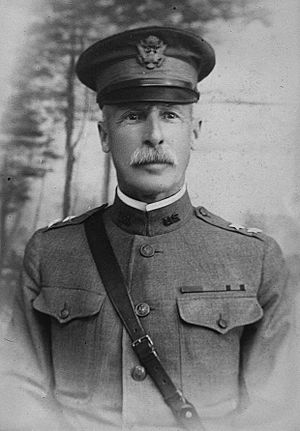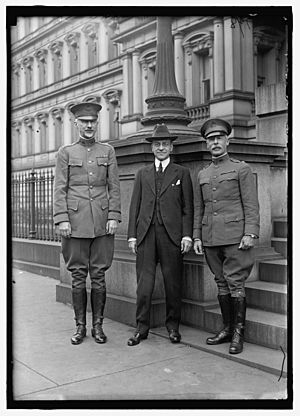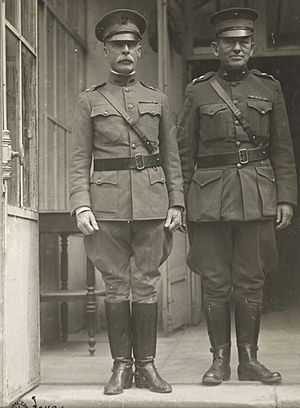Omar Bundy facts for kids
Quick facts for kids
Omar Bundy
|
|
|---|---|
 |
|
| Born | June 17, 1861 New Castle, Indiana, United States |
| Died | January 20, 1940 (aged 78) Washington, D.C., United States |
| Buried |
Arlington National Cemetery, Virginia, United States
|
| Allegiance | |
| Service/ |
|
| Years of service | 1883–1925 |
| Rank | |
| Service number | 0-31 |
| Unit | |
| Commands held | 16th Regiment 1st Brigade 2nd Division VI Corps VII Corps Fort Lee, Virginia Philippine Division Seventh Corps Area Fifth Corps Area |
| Battles/wars | American Indian Wars Spanish–American War Philippine–American War Pancho Villa Expedition World War I |
| Awards | Army Distinguished Service Medal Silver Star (2) Legion of Honor (France) Croix de Guerre (France) 2nd Division Medal |
| Spouse(s) | Adda Love "Addie" Harden (m. 1889-1940, his death) |
Major General Omar Bundy (born June 17, 1861 – died January 20, 1940) was an important U.S. Army officer. He served in many wars, including the American Indian Wars, the Spanish–American War, the Philippine–American War, the Pancho Villa Expedition, and World War I.
Bundy was born in New Castle, Indiana. He graduated from West Point in 1883. He started his career as a second lieutenant in the Infantry. He served on the U.S. western frontier and in the American Indian Wars.
During the Spanish–American War, Bundy fought in Cuba. He took part in the Battle of El Caney and received the Silver Star for his bravery. He also served several times in the Philippines, including during the Philippine–American War. He earned a second Silver Star there. Later, he was part of the Pancho Villa Expedition.
In World War I, Bundy led the 2nd Division in France in 1918. He was later promoted to command the U.S. VI Corps and then the U.S. VII Corps. For his service, he received the French Legion of Honor and the French Croix de Guerre. After the war, Bundy commanded several military areas.
Bundy retired in 1925 and lived in Washington, D.C.. He passed away in 1940 and was buried at Arlington National Cemetery.
Contents
Early Life and Education
Omar Bundy was born in New Castle, Indiana, on June 17, 1861. His parents were Judge Martin Bundy and Amanda (Elliott) Bundy. His family had a history of military service. His father was a paymaster for the Union Army during the American Civil War. His great-grandfather, Christopher Bundy, fought in the American Revolution.
Bundy went to grammar and high school in New Castle. He then attended Asbury College (now DePauw University) from 1878 to 1879. In 1879, he was chosen to attend the United States Military Academy (USMA) at West Point, New York. He graduated from West Point in 1883. Many of his classmates also became general officers.
Beginning His Military Career
After graduating, Bundy became a second lieutenant in the Infantry. He was first sent to the 2nd Infantry Regiment in Fort Lapwai, Idaho. In 1884, he moved to the 3rd Infantry at Fort Missoula, Montana.
From 1885 to 1887, Bundy studied at Fort Leavenworth's Infantry and Cavalry School. He then returned to the 3rd Infantry. In 1888, he took part in an American Indian Wars mission against the Crow near Fort Custer, Montana. The 3rd Infantry later moved to Fort Meade, South Dakota.
In May 1890, Bundy was promoted to first lieutenant. During the winter of 1890-1891, he joined an expedition against the Sioux. From 1891 to 1898, Bundy served with the 3rd Infantry at Fort Snelling, Minnesota. He was often the quartermaster, managing supplies. He became a captain in April 1898.
Service in the Spanish–American War
When the Spanish–American War began in 1898, Bundy was offered a job as a commissary officer, but he said no. In May, he traveled with the 3rd Infantry to Mobile, Alabama. From there, they sailed to Cuba in June. His regiment was part of the Fifth Army Corps.
Bundy fought bravely in the Battle of El Caney in July 1898. He received the Silver Star for his actions. After this battle, Bundy also took part in the Siege of Santiago in July 1898. Then, he returned to the United States.
Continuing His Military Path
After serving in Cuba, Bundy worked as a recruiter in Milwaukee, Wisconsin, for eight months. In March 1899, he joined the 6th Infantry Regiment at Fort Sam Houston, Texas. He served as the regiment's quartermaster. In May 1899, the 6th Infantry sailed to the Philippines for the Philippine–American War.
Bundy fought against rebels on Negros Island. He also served as an inspector general and provost marshal in the Visayas region. In 1902, Bundy returned to the United States. He became a teacher at Fort Leavenworth's United States Army Command and General Staff College. In July 1904, he was promoted to major.
In 1905, he went back to the Philippines with the 6th Infantry. He helped respond to the Moro Rebellion. He fought in the First Battle of Bud Dajo in March 1906. For his service in the Philippines, Bundy received a second Silver Star.
Bundy returned to the U.S. in 1907. He was stationed at Fort William Henry Harrison, Montana. Later that year, he became an inspector general in Chicago, Illinois, and then in Texas. From 1909 to 1911, he worked in Omaha, Nebraska. He was promoted to lieutenant colonel in March 1911.
From 1911 to 1912, Bundy was with the 11th Infantry Regiment. He then attended the United States Army War College, graduating in July 1913. He rejoined the 11th Infantry in Texas City, Texas. In July 1914, Bundy became a colonel. In August, he took command of the 16th Infantry Regiment in El Paso, Texas. From 1915 to 1917, Bundy served in the Pancho Villa Expedition.
World War I Service
In May 1917, the U.S. joined World War I. Bundy was promoted to brigadier general. In June, he took command of the new 1st Brigade. This brigade was part of the 1st Division. The division soon sailed to France as part of the American Expeditionary Forces (AEF).
In August, Bundy was promoted to temporary major general. He helped find and prepare places for the AEF to live and train.
Bundy took command of the 2nd Division in November 1917. This division was special because it included a brigade of U.S. Marines. In March 1918, the 2nd Division was sent to a quiet part of the front line in France. In May, German forces launched a big attack. The 2nd Division had to move to different areas.
The division then fought in the June 1918 Battles of Battle of Belleau Wood and Chateau-Thierry. During the German advance, the French commander ordered Bundy's division to retreat. Bundy refused and instead launched a successful counterattack.
In July, Bundy was assigned to command the new U.S. VI Corps. Brigadier General James Harbord took over the 2nd Division. In his new role, Bundy helped with a trick called the Belfort Ruse. This helped the U.S. succeed in the Battle of Saint-Mihiel in September. Later that month, Bundy was named to command the U.S. VII Corps. He led this corps until he returned to the United States just before the war ended on November 11, 1918.
For his service in the war, Bundy received the French Legion of Honor and the French Croix de Guerre.
After World War I
After World War I, Bundy was appointed to command Fort Lee, Virginia. He stayed there until August 1920. In June 1920, he returned to his permanent rank of brigadier general. From 1920 to 1922, he commanded the Seventh Corps Area in Nebraska. In December 1921, he was promoted to permanent major general.
Bundy commanded the Philippine Division from April 1922 to March 1924. From May 1924 to June 1925, he was commander of the Fifth Corps Area in Ohio.
Later Life and Passing

Bundy retired from the military on June 17, 1925, when he turned 64. At his retirement, he received the Army Distinguished Service Medal. In January 1934, President Franklin D. Roosevelt gave him the 2nd Division Medal. This was a special award from the 2nd Division Veterans' Association.
In 1938, Bundy had a stroke. This left him partly paralyzed and in poor health. He passed away in Washington, D.C., on January 20, 1940, at age 78. This was just four months after World War II started in Europe. Bundy was buried in Section 3 of Arlington National Cemetery.
Family Life
On November 27, 1889, Bundy married Adda Love "Addie" Harden (1866-1953). Their wedding was in New Castle's First Presbyterian Church. Addie's father, William H. Harden, was the treasurer of Henry County, Indiana. Omar and Addie were married until his death. They did not have any children.
Legacy and Honors
In 1919, DePauw University gave Bundy an honorary degree called LL.D..
A poem by Willis O. Robb, called Where Bundy Held the Paris Road, honored Bundy's bravery in World War I.
A United States Navy ship, the USS General Omar Bundy (AP-152), was named after him. This troop transport ship was built for World War II. It was launched in August 1944. After the war, it was sold for commercial use and renamed. The ship was in service until 1980, when it was reported missing and believed to have sunk.




